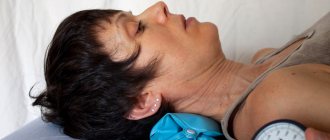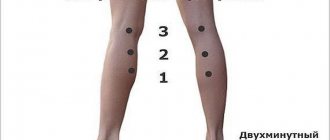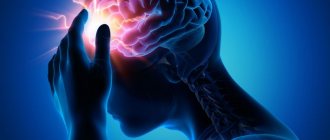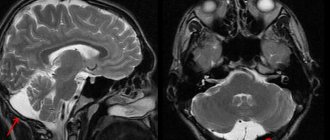Not a sign of illness, but a temporary glitch
Sometimes the problem is not so bad if it is not directly related to health. In some situations, numbness in the head is considered normal, since overstrained muscles are to blame.
Short-term numbness or tingling is usually observed after waking up if the person took uncomfortable positions during sleep.
Being in one position for a long time (for example, sitting at a computer), the muscles experience severe tension and become “numb.” Compression or pinching of the nerve may also occur.
A feeling of numbness in the head and goosebumps are considered normal even with sudden movements of the neck. In such a situation, the blood vessels experience an unexpected spasm.
Each of these moments is accompanied by disruptions in the blood circulation of the brain, which sometimes leads not only to numbness, but also to dizziness. The condition, which is considered normal, lasts for 10-15 minutes. It is enough to wait until the discomfort passes.
Temporary disruptions can be caused by exposure to certain medications. Numbness of the head is often accompanied by taking statins. It is enough to stop taking them, and the symptoms will go away on their own.
Prevention methods
To maintain the health of your back and joints, nerves and blood vessels, it is important to follow some rules of prevention. Doctors at the Clinical Brain Institute recommend:
- maintain a healthy diet - consume a sufficient amount of vitamins and microelements, and also avoid excess animal fats, salt and spices, and carbonated drinks;
- get rid of bad habits - smoking and alcohol abuse have a detrimental effect on the condition of the heart and blood vessels;
- regularly perform simple exercises for the health of the back and spine - they will increase the elasticity of the ligaments and strengthen the muscles;
- Spending enough time in the fresh air is a prerequisite for adequate oxygen supply to the brain cells;
- at the first symptoms, including headaches, numbness of the limbs, deterioration in health, it is important to immediately contact a specialist to receive competent medical care.
The Clinical Brain Institute is a multidisciplinary center that specializes in the treatment of headaches of various origins. Here you can undergo a full examination and receive a comprehensive treatment regimen for pain in the head and numbness in the hands. The doctors of our center are competent specialists of a wide and narrow profile. Treatment is prescribed individually, depending on the diagnostic results, and can take place either on an outpatient basis or in a comfortable hospital.
Neurological and other diseases
There are many reasons why the head goes numb in one part or another, but very often this is a symptom of one of the neurological diseases:
- Often this condition is accompanied by problems of the cervical spine. The most common disease in this area is osteochondrosis , which leads to pinched nerves, which provokes not only discomfort in tactile sensations, but also stiffness in head movements.
- Vascular diseases of the brain and cerebrovascular disease are another diagnosis in which the described symptom is present.
- Such symptoms are also observed with head and spinal injuries . Injuries to the back or cervical region, as well as the head, are accompanied not only by “goosebumps” on the body, but also by severe pain, paralysis and many other symptoms.
- It cannot be avoided without numbness of the scalp and with neuroinfections .
- multiple sclerosis develops , the essence of which is the replacement of nervous tissue with connective tissue. This results in numbness of the skin on the head, poor sensitivity of the limbs, and incoordination.
- Tumors of the head or spine , growing, begin to put pressure on neighboring areas, expanding their space. Nerves and blood vessels come under pressure (and displacement), and metastases penetrate the tissue. The processes are accompanied not only by numbness, but also by very severe pain.
The most serious diseases for which numbness is a mandatory symptom relate to the field of oncology. The tumor can be localized in the cervical region or in any part of the brain.
Numbness, goosebumps and tingling are manifestations of sensitivity of the scalp, and the longer such sensations last, the more compelling the reasons that provoke them should be.
The most harmless are colds associated with hypothermia.
Heart disease, hypertension, excess weight lead to disruption of normal blood circulation, which causes vasospasm, resulting in numbness. This condition can be regarded as pre-stroke.
It is impossible to diagnose or eliminate all these factors independently (without the participation of doctors). Therefore, traditional treatment is excluded a priori here.
Causes of headaches and numbness in hands
For headaches that are accompanied by numbness in the hands, it is important to make a timely diagnosis and determine the cause of these symptoms. They can be triggered by various factors, including poor circulation, low blood pressure and others. In addition, a sharp deterioration in health indicates the development of a stroke, rehabilitation for which is most effective when seeking medical help within the first two hours after the attack.
Stroke
Main article: Stroke
A stroke is an acute disruption of the blood supply to the brain. As a result of oxygen starvation, necrosis (death) of certain areas occurs, which is accompanied by disruption of nervous activity. Typical signs of a stroke are loss of consciousness, headaches, asymmetrical work of the muscles of the face and body, memory loss and deterioration of mental activity. These symptoms are individual for each patient and depend on the size and exact location of the affected area.
A stroke can occur without obvious symptoms, but cause long-term consequences and pose a danger to the patient’s life. To identify it in the early stages, there are several tests that can be performed at home:
- Face – when trying to smile, the corners of a person’s mouth rise unevenly;
- Hands - the victim will not be able to hold both hands in front of him for 10 seconds, one hand will fall down;
- Speech – speech becomes unintelligible, difficulties arise when trying to repeat a simple sentence;
- Time is a warning that if at least one symptom is present, a person’s life is in danger, and it is important to get to the hospital as quickly as possible.
Risk factors for stroke include old age, bad habits, excess weight, sedentary lifestyle, as well as chronic heart and vascular diseases. Thus, atherosclerosis is vascular damage that occurs due to the deposition of cholesterol and lipoproteins on the walls of the arteries. An unhealthy diet high in animal fats can cause deterioration in the elasticity of blood vessels and cause a stroke. Smoking and alcohol abuse are factors that also affect the intensity of blood supply to the brain. However, a stroke can be a consequence of hidden pathologies or occur suddenly in a young person with a healthy cardiovascular system.
Diseases of the neck and spine
Main article: Headache and neck pain
Neurological symptoms and headaches can also result from compression of the nerves in the cervical spine. Thus, the nerves of the cervical plexus innervate the occipital part of the head, so their damage will be accompanied by acute pain. Also in this area, nerves originate that carry impulses to the upper limbs. Headaches, numbness of the hands - these are a typical picture for a number of diseases:
- Osteochondrosis of the cervical spine (Main article: Headache with osteochondrosis of the cervical spine) is a chronic process in which there is a slow destruction of intervertebral cartilage. They become less elastic, thinner, and therefore cannot fully absorb shock during movement. This leads to insufficient mobility of the neck, pain, and a decrease in the clearance between the vertebrae. Bone segments compress blood vessels and nerves, which is accompanied by a deterioration in nerve conduction and blood circulation.
- Protrusion is a protrusion of the intervertebral disc on one side. Normally, it follows the shape of the vertebrae, but can be displaced as a result of injuries, weakness of the spinal ligaments, as well as uneven pressure on the vertebrae on both sides. Protrusions are treated with special gymnastics, massage, swimming, taking painkillers and muscle relaxants, and you may need to wear a collar. The disease progresses, and over time, if left untreated, progresses to the following stages. The last of them is intervertebral hernia, in which the dense fibrous membrane of the cartilage ruptures.
- Injuries and their consequences pose a danger to the health and life of the patient. Fractures of the vertebral bodies and processes, ruptures of ligaments lead to acute pain and require long-term rehabilitation. In the future, inactivity may persist in certain areas, increasing the risk of developing osteochondrosis and other chronic diseases.
Diseases of the cervical spine require long-term treatment. Its effectiveness will depend on regular exercise at home, as well as on compliance with other doctor’s recommendations. It is important to understand that in case of osteochondrosis, protrusions and hernias, it is necessary to monitor your posture throughout the day, dosage physical activity, and also not endure pain and attacks of numbness in the hands - with these disorders it is always worth making an appointment with a doctor for examination.
Diseases of the heart and blood vessels
Diseases of the cardiovascular system also lead to headaches, numbness in the hands and other alarming symptoms. They can occur in acute and chronic forms, be congenital and acquired. Thus, congenital heart defects, structural anomalies of valves and large vessels are accompanied by deterioration of blood circulation at any age. However, acquired disorders are more often diagnosed:
- Hypotension (See: Headache with low blood pressure) is a chronic decrease in blood pressure. Blood spreads slowly throughout the body, so the speed of blood flow in the upper extremities and head is significantly reduced. This leads to hypoxia (oxygen starvation) of tissues and deterioration of their innervation. For hypotension, complex treatment aimed at increasing blood pressure is prescribed.
- Atherosclerosis (See: Headache as a symptom of atherosclerosis) is a metabolic disorder in which deposits of cholesterol and lipoproteins appear on the inner walls of the arteries. These substances narrow the lumen of blood vessels, thereby impeding blood flow. In the future, they can form plaques and completely block the arteries, posing a danger to the patient’s life. Circulatory disorders are diagnosed using vascular ultrasound with the addition of a contrast agent. This allows you to determine the exact location of the damaged area and make a diagnosis. As treatment, a diet low in fat and cholesterol is prescribed, as well as drugs that stimulate its elimination.
- Aneurysm is a pathological expansion of a section of blood vessels (usually arteries) with the formation of a pocket filled with blood. At the same time, their walls become significantly thinner, and there is a risk of their rupture, especially with increased pressure. In the presence of an aneurysm, neurological symptoms, frequent headaches, and numbness of the hands occur. It is important for patients to monitor their well-being; according to the doctor’s decision, a planned operation is performed to restore the damaged area of the vessel.
Chronic diseases of the heart and blood vessels, if left untreated, can cause a stroke. Thus, narrowing of the lumen of the arteries and hypotension are provoking factors for the development of ischemic stroke, which occurs during prolonged hypoxia of parts of the brain. An increase in pressure to critical levels can provoke a hemorrhagic stroke - it occurs when a vessel ruptures and is accompanied by cerebral hemorrhage. According to statistics, hemorrhagic stroke is more life-threatening, and rehabilitation in this case is less effective, but the prognosis is determined individually, depending on the degree of damage and the exact area of the brain.
Features of the clinical picture and localization of sensations
When numbness of the head does not belong to the category of normal, then we are talking about the clinic, the etiology of which can only be determined by a doctor.
Having assessed the nature of the symptoms, the location of the sensations, taking into account the presence of specific diseases, as well as carrying out the appropriate diagnostics, the specialist will render his verdict.
Numbness of the head can be complete, but sometimes only a specific part of it is affected, which indicates dysfunction of certain organs. The nervous system most often affected is:
- If the left or right side of the head goes numb, then the culprit may be vessels in which blood circulation is impaired, or pinched nerves. But sometimes the cause is brain pathologies and cerebral tumors.
- If the back of the head , then usually the cause is cervical osteochondrosis or other disorders of the cervical region.
- Numbness and tingling in the front of the head is caused by inflammation of the trigeminal nerve. A sign of this is pain radiating to the jaw, ear and eye.
- The frontal part is affected by increased intracranial pressure.
A problem localized to only one side of the head indicates a pathology of the cerebral structure. In this case, the focus is concentrated in the opposite area of the skull.
Numbness on the left and right sides of the body: what are the differences?
Numbness of the right arm or leg, simultaneous or sequential, occurs with osteochondrosis, scoliosis, herniated intervertebral discs, when the blood supply to tissues and the conductivity of nerve endings are disrupted. If this syndrome was preceded by a sensitive acute headache or injury, the cause may be much more serious - a stroke or a brain tumor.
When a sensitivity disorder is observed on the left side of the body, a person feels a tingling sensation, and the motor functions of the limbs suffer. If at the same time the facial muscles go numb, blood pressure rises, and dizziness appears, this suggests an ischemic or hemorrhagic stroke or serious pathologies of cerebral circulation. Therefore, numbness on the left is considered a more dangerous symptom than on the right.
Diagnostic measures
A multifaceted examination of the patient’s condition will help the doctor determine the location of the source of the problem and its cause. In addition to visual diagnosis and analysis, a differential study is added, which allows one to completely determine the cause and extent of the lesion.
Set of research procedures:
- start with a general blood test , which allows us to identify a lack of vitamin B12 in the body and the presence of iron deficiency anemia;
- instrumental studies such as radiography and spiral computed tomography will make it possible to assess the condition of the brain, skull, spine and identify pathologies if they are present;
- Electroneuromyography will help find the damaged nerve ;
- Doppler ultrasound makes it possible to assess the condition of blood vessels and help diagnose diseases of the cardiovascular system;
If after these studies and tests the picture remains not completely clear, the doctor will prescribe additional procedures based on the patient’s condition.
Diagnosis of the condition
To make a diagnosis, you need to contact a neurologist, he will conduct an examination and determine the localization of numbness using skin tests, then identify the circumstances of the complaints (for example, previous trauma, infection, hypothermia). Information about concomitant diseases (hypertension, diabetes) will be important. The rate of increase in symptoms allows you to narrow the direction of the diagnostic search. For example:
- instant numbness occurs with stroke and injury;
- during infection, symptoms increase from several hours to 2-3 days;
- weeks and months covering an increasingly larger area are typical for the tumor process, multiple sclerosis.
To clarify the affected area and the cause of numbness, the following is prescribed:
- X-ray of the cervical spine;
- Ultrasound of head and neck vessels;
- neurophysiological testing (electroneuromyography) – determining the speed of propagation of a nerve signal;
- MRI of the brain;
- blood tests: general, biochemistry (renal tests, glucose, glycated hemoglobin, magnesium, calcium, potassium, sodium), level of vitamin B12, folic acid;
- test for thyroid-stimulating hormone of the pituitary gland;
- immunological tests (for antibodies if infection is suspected, plasma protein electrophoresis).
The patient may need to consult an infectious disease specialist, endocrinologist, oncologist, or surgeon.
First aid
When there is short-term numbness of the head, which is normal, you can relieve tension with a light massage.
If there is discomfort caused by pathology, this will not work - you must first eliminate the cause (and only a doctor can identify it). You should not look for ways to “help” yourself, so as not to harm yourself even more with self-medication.
The main step that the patient must take is to immediately go to a medical facility. If you cannot do this yourself, you must call an ambulance.
When do you urgently need to see a doctor?
Not everyone perceives periodically occurring long-term numbness and tingling in the head as a reason to see a doctor. But when the following accompanying symptoms occur, it’s time to sound the alarm:
- Tingling and numbness are often accompanied by dizziness and lightheadedness . Here, constant drowsiness, general weakness and unsteadiness of gait are possible.
- Nausea appears, often ending in vomiting . It is difficult for the patient to control the bladder - it is emptied involuntarily.
- , musculoskeletal dysfunction may occur . Problems arise either in individual parts of the body, or complete paralysis occurs.
- Difficulty with movement also affects speech , the tongue becomes numb, and it is impossible to understand what the person is saying.
Even one of the factors described is already a serious reason to visit a neurologist or surgeon if it is related to injury.
Treatment approach
Complex treatment is prescribed only after a complete examination of the patient. The doctor prescribes medications individually for each patient, taking into account the reasons that led to numbness of the head.
The first step in therapy will be blocking pain, reducing temperature (if present) and administering drugs that restore circulatory function.
If numbness is a symptom of one of the diseases, then the main goal will be to treat this disease. In some cases, you will have to settle for long-term therapy and no less long-term rehabilitation.
A positive treatment outcome in this situation will depend not only on the doctors, but also on the patient himself, who takes full responsibility for his condition.
The symptoms described above should not be ignored. The sooner the patient goes to a medical facility, the easier and faster the treatment will be. Every day of delay reduces the chances of recovery and provokes serious consequences.
Treatment methods for loss of sensation in the head
The scope of treatment for loss of sensation in the head completely depends on the disease. For example, for the most common disease – osteochondrosis, the following is prescribed:
- painkillers from the group of non-steroidal anti-inflammatory drugs: Diclofenac, Ketonal, Ibuprofen;
- relaxing muscles: Mydocalm, Sirdalud;
- decongestants: Hypothiazide, Lasix;
- stimulating metabolic processes: Rumalon, Actovegin;
- improving nerve functions: Milgamma, Berlition;
- facilitating venous outflow: Troxevasin, Aescusan;
- normalizing microcirculation (Trental, Xanthinol nicotinate);
- activating the transmission of nerve impulses: Neuromidin.
The required group of drugs is selected based on the prevailing symptoms. In addition to medications, it is recommended to wear a Shants collar to relieve the load on the spine. Physiotherapy helps well - in the acute stage, UHF, the introduction of Hydrocortisone with ultrasound, acupuncture, and during the recovery period massage and physical therapy are indicated.
A similar approach is used in the treatment of neuritis and neuralgia. If there is a tumor process, a herniated disc, or spinal instability, surgery is needed. It is also recommended if the full course of drug therapy is ineffective.
If the cause of numbness is cerebral vascular disease, then the following drugs are used:
- cholesterol-lowering drugs (Vasilip, Roxera);
- calcium channel blockers (Corinfar, Nimotop);
- improving cerebral blood flow (Pentilin, Bilobil);
- reducing blood viscosity (Curantil, Aspirin);
- protecting against lack of oxygen (Nootropil, Ceraxon);
- B vitamins (Neurobion, Milgamma).









